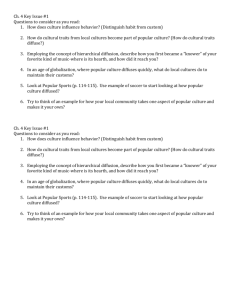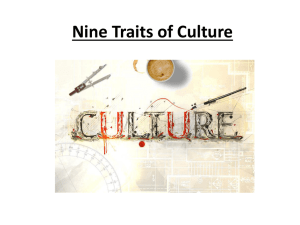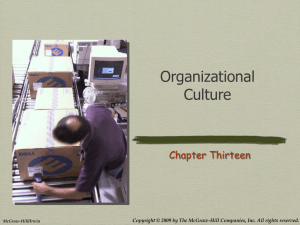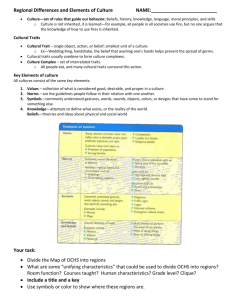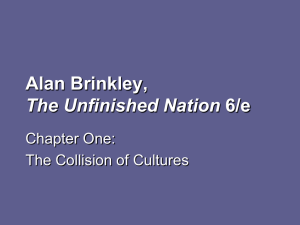Chapter 4
advertisement
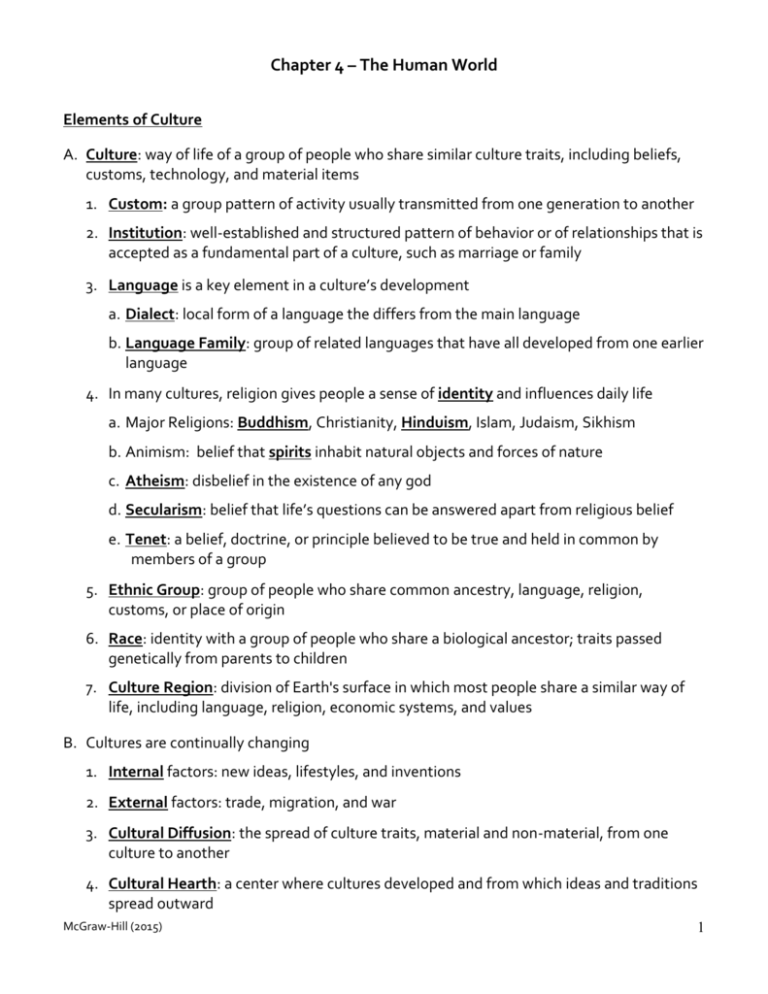
Chapter 4 – The Human World Elements of Culture A. Culture: way of life of a group of people who share similar culture traits, including beliefs, customs, technology, and material items 1. Custom: a group pattern of activity usually transmitted from one generation to another 2. Institution: well-established and structured pattern of behavior or of relationships that is accepted as a fundamental part of a culture, such as marriage or family 3. Language is a key element in a culture’s development a. Dialect: local form of a language the differs from the main language b. Language Family: group of related languages that have all developed from one earlier language 4. In many cultures, religion gives people a sense of identity and influences daily life a. Major Religions: Buddhism, Christianity, Hinduism, Islam, Judaism, Sikhism b. Animism: belief that spirits inhabit natural objects and forces of nature c. Atheism: disbelief in the existence of any god d. Secularism: belief that life’s questions can be answered apart from religious belief e. Tenet: a belief, doctrine, or principle believed to be true and held in common by members of a group 5. Ethnic Group: group of people who share common ancestry, language, religion, customs, or place of origin 6. Race: identity with a group of people who share a biological ancestor; traits passed genetically from parents to children 7. Culture Region: division of Earth's surface in which most people share a similar way of life, including language, religion, economic systems, and values B. Cultures are continually changing 1. Internal factors: new ideas, lifestyles, and inventions 2. External factors: trade, migration, and war 3. Cultural Diffusion: the spread of culture traits, material and non-material, from one culture to another 4. Cultural Hearth: a center where cultures developed and from which ideas and traditions spread outward McGraw-Hill (2015) 1 5. Acculturation: when a society changes because it accepts or adopts an innovation 6. Cultural Divergence: the separation of cultures through less and less contact and interaction between them; restriction of a culture from outside influences 7. Cultural Convergence: contact and interaction of one culture and another 8. Assimilation: occurs when the original traits of the weaker culture are completely erased and replaced by the traits of the more dominant culture 9. Industrial Revolution: period of major industrialization during the late 1700s and early 1800s; marked by the general introduction of power-driven machinery or by an important change in the prevailing types and methods of use of such machines C. Information Revolution: the explosion of availability of information due to the use of computers, the Internet, and other electronic devices at the end of the 20th century 1. Globalization: the expansion of economic, political, and cultural processes to the point that they become global in scale and impact 2. Connectivity: the degree of connection between people, places, and things 3. Benefits of globalization: a. Standard of Living: the level of wealth, goods, and necessities available b. Larger selection of goods and services c. Growth of creativity and innovation d. New technology e. Greater cooperation and awareness f. Great access to foreign cultures 4. Challenges of globalization: a. Outsourcing: setting up businesses abroad to produce parts and products for domestic use or sale b. Increasing gap between rich countries and poor countries c. Loss of culture d. Pandemic: the spread of disease across a large area or even the world D. Migration fosters cultural diffusion 1. Positive factors (pull factors): better social and economic conditions; religious or political freedom 2. Negative factors (push factors): wars, persecution, and famine McGraw-Hill (2015) 2 Population Geography A. Population Growth: more than 7 billion people live on Earth 1. Birth Rate: number of births per year for every 1,000 people 2. Death Rate: number of deaths per year for every 1,000 people 3. Natural Increase: the growth rate of a population; the difference between birthrate and death rate 4. Migration: the movement of people from place to place 5. Demographic Transition: the model that uses birthrates and death rates to show how populations in countries or regions change over time STUDENTS HAVE SPACE FOR ADDITIONAL NOTES 6. Zero Population Growth: birth rate and death rate are equal 7. Some cultural beliefs and economic factors encourage large families 8. Doubling Time: the number of years it takes for population to double in size 9. Population Pyramid: diagram that shows distribution of a population by age and gender McGraw-Hill (2015) 3 STUDENTS HAVE SPACE FOR ADDITIONAL NOTES B. People are not distributed evenly across the Earth or across countries 1. Population Distribution: the variations in population that occur across a country, a continent, or the world a. Related to Earth’s physical geography b. People usually live where there is fertile soil, available water, and climate is not extreme 2. Population Density: the average number of people living on a square mile or square kilometer of land Political Geography A. The government of each country relates to that country’s historical development 1. Unitary System: form of government in which all key powers are given to the national or central government 2. Federal System: form of government in which powers are divided between the national government and the state or provincial governments 3. Autocracy: system of government in which one person rules with unlimited power and authority 4. Monarchy: a form of autocracy with a hereditary king or queen exercising supreme power 5. Oligarchy: system of government in which a small group holds power 6. Theocracy: system of government in which the officials are regarded as divinely inspired 7. Democracy: system of government in which leaders rule with consent of the citizens McGraw-Hill (2015) 4 B. Geographic areas can determine how political and administrative units are drawn and how they will be governed 1. Natural Boundary: a fixed limit or extent defined along physical geographic features such as mountains and rivers 2. Cultural Boundary: a geographic boundary between two different cultures 3. Geometric Boundary: a boundary that follows a geometric pattern 4. Nationalism: belief that an individual’s loyalty to the nation or state should surpass other individual or group interests 5. Terrorism: any violent and destructive act committed to intimate a people or government 6. Countries work together through alliances, treaties, and international organizations to resolve conflicts and establish ways to share resources Economic Geography A. An economic system determines what goods and services to produce, how to produce them, and who receives them 1. Traditional Economy: tradition and custom control all economic activity; exists in only a few parts of the world today 2. Market Economy: based on free enterprise, in which businesses are privately owned and production and prices are determined by supply and demand 3. Free Enterprise: private individuals or groups have the right to own property or businesses and make a profit with limited government interference 4. Capitalism: factors of production are privately owned 5. Mixed Economy: the government supports and regulates enterprise through decisions that affect the marketplace 6. Command Economy: decisions about production and distribution of goods and services are made by a central authority a. Socialism: government owns some, but not all basic productive resources; provides some basic needs such as education and health care b. Communism: no private property; one political party (Communist) makes all decisions B. Four levels of economic activity: 1. Primary: taking or using natural resources directly from the Earth a. Farming, grazing, fishing, forestry, and mining 2. Secondary: use raw materials to make a tangible product that is more valuable than the raw material McGraw-Hill (2015) 5 a. manufacturing, assembling electronic goods, producing electric power, or making pottery 3. Tertiary: provide services to people or businesses a. Doctors, teachers, lawyers, bakers, truck drivers, and store clerks 4. Quaternary: services involving complex processing and handling of information a. Scientists, engineers, computer specialists, financial mangers C. Economic activities influence a country’s level of economic development 1. Industrialization: spread of industry 2. More Developed Country: has a highly developed economy and advanced technological infrastructure relative to other less developed nations 3. Newly Industrialized Country: has begun transitioning from primarily agricultural to primarily manufacturing and industry activity 4. Less Developed Country: according to the United Nations, exhibits the lowest indicators of socioeconomic development Key Development Factors Comparison More Dev Country New Dev Country Less Dev Country Literacy High 60-95% Low Doctor-Patient Ratio Low Varies High Civil-Human Rights Protected Sometimes Unprotected Citizen Government High Low-Med Low Government Stable Somewhat Unstable Life Expectancy High Increasing Low Infant Mortality Low Decreasing High Birth Rate Low Decreasing High 5. Human Development Index (HDI): a way to measure people’s well-being rather than just their income; considers things such as: life expectancy, literacy, and per capita GNP D. World Trade: the exchange of capital, labor, goods, and services across international borders 1. Natural resources are unevenly distributed 2. Labor costs and education vary in different countries 3. Commodity: something useful that can be bought or sold McGraw-Hill (2015) 6 4. Import: to bring a commodity into a country to be sold 5. Export: a commodity sent from one country to another for purposes of trade 6. Emerging Markets: nations with social or business activity in the process of rapid grown and industrialization Urban Geography A. The industrial Revolution sparked an age of urbanization 1. Urbanization: the relocation of people from rural areas to urban areas 2. Urban Sprawl: spreading of urban developments on undeveloped land near a city 3. Connectivity: the directness of routes linking pairs of places 4. Metropolitan Area: region that includes a central city and its surrounding suburbs 5. Three models explain the structure of cities and how they grow: a. Concentric Model: a city grows outward from a central point in a series of rings b. Sector Model: certain areas of a city are more attractive for various activities c. Multiple Nuclei Model: a city contains more than one center around which activities revolve 6. Central Place Theory: seeks to explain the number, size, and location of human settlements in an urban system 7. World Cities: cities generally considered to play an important role in the global economic system B. Challenges of urbanization: 1. Rapid growth strains ability to provide services: energy, education, health care, transportation, sanitations, and physical security 2. Problems include poor housing, homelessness, pollution, and social problems such as addiction, crime, and gang violence McGraw-Hill (2015) 7 3. Smart Growth (New Urbanism): cities plan growth McGraw-Hill (2015) 8
